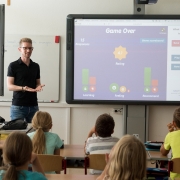The Public Perception of Teachers
Joe Nutt
Author and Educational Consultant
The Public Perception of Teachers
Even while teachers continue to battle on as key workers, and some state schools buckle and close under the pressure of trying to operate effectively under politically imposed restrictions, curiously the profession remains in the public and press firing line. All kinds of voices have been raised against teachers, even in the midst of such remarkably difficult circumstances.
Which got me thinking hard about why teachers so often polarise opinion and provoke negative reactions amongst none teachers, because like it or not, they do.
A company I worked for some years ago set up a regular event to invite leading educational figures to talk to its senior managers about current educational issues. I invited an extremely high profile headteacher to one of these events and on this occasion, almost everyone in the business with a senior role was there. Nonetheless, my guest addressed a room full of experienced, professional businessmen and women, as though he was teaching an A level Economics class – bottom set.
I recognised immediately, as an ex-teacher myself, that his tone and demeanour were exactly the same he used in his own classroom. Yet throughout he appeared totally unaware of this, as well as the detrimental effect he was having. He simply could not abandon his role as the single voice of authority in any physical space. It was as though someone had secretly flicked a teacher switch, located somewhere on his spine, the moment he stood in front of the lectern.
His gaze wandered infuriatingly somewhere midway between the ceiling and the adults sitting politely in front of him but never engaged with them. Statements were delivered relentlessly, one after another, as though no one could possibly challenge them and I can vividly remember the parade of glowering faces that left the room. For around forty-five, deeply uncomfortable minutes, instead of helping them better understand the market they all worked in, he successfully confirmed every negative prejudice those professional adults already had about teachers. As one of a small number of ex-teachers working for that company, in less than an hour he had made my job exponentially more difficult.
I finally grasped what is really going on much more recently while watching a CPD event the pandemic had forced to go online, delivered by a teacher. The software application he was using allowed viewers to see the presenter in a tiny window, at the same time as he was writing on a larger whiteboard. The content was fine. It was informative, relevant and interesting but his tone, even online, really grated because it was exactly the one he would have used talking to twelve-year-olds. He didn’t shift register at all to match his adult audience, even whilst occasionally using a researcher’s vocabulary. Even though none of us were in the same room and everything was done digitally, the experience was no different from the one I’d unwittingly imposed on colleagues, at my previous employer.
I suppose you could argue this might not matter in the least if you’re a teacher addressing other teachers, but if you’re being interviewed on the BBC’s flagship news programme Today, because you’re the leader of the largest teachers’ organisation in the country, it might be wise to understand this. It might stop you from replying to every question from Nick Robinson with the barked imperative, “Listen” as though you are reprimanding a rude toddler. Because that is exactly what Mary Bousted, the CEO of the NEU did, in the middle of round two of her union’s bare-knuckle fight with the government over Covid policy. What Radio Four listeners made of it I can only imagine, because she did nothing to enhance the public perception of teachers.
If I needed any confirmation that I was right about this, then it came even more dramatically, when I was attending another online educational event. It wasn’t long before I was witnessing yet another teacher doing exactly the same and I was so frustrated I tweeted this: A general plea to all teachers ever put in the position of delivering a presentation to any adult audience. Please don’t use exactly the same tone and register you would use talking to twelve-year-olds. It is so off-putting.
It struck an immediate chord, judging by the reaction. But far more interestingly, it earned me immediate removal from the event by the organiser, who was clearly not prepared to tolerate even anonymised criticism, as I made sure not to put the link to the event in my tweet which the organisers had asked everyone to use.
If teachers really want the public perception of them to improve, they need to understand the real world much better. They need to appreciate that addressing adults requires they think extremely carefully about how they go about it.
There are undoubtedly aspects of their routine work that can transfer effectively to the real world. The confidence it takes to address an audience; the ability to structure information so that it’s easily assimilated; emphasis, repetition and even humour, are all tools good teachers routinely carry with them. But all of these count for nothing if you don’t grasp that grown-ups expect to be addressed as such.
What do you think about the points raised in this article? We’d love to have your thoughts below.
ABOUT THE AUTHOR

Joe Nutt is the author of several books about the poetry of Donne, Milton and Shakespeare and a collection of essays, The Point of Poetry. His most recent book, Teaching English for the Real World was published in May by John Catt.
He is an international educational consultant who spent almost 20 years teaching, unusually in schools ranging from the highly selective, private sector to challenging, inner-city state schools. The second half of his career has been in business and he has implemented a number of major educational projects including the national intranet for Scotland, Glow, which won the Global Learning Impact Award in 2009.













